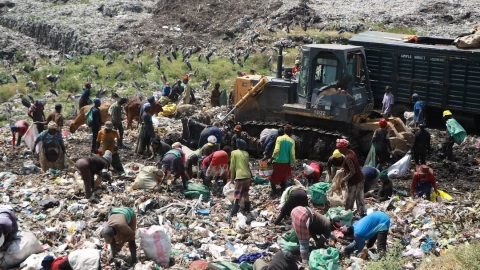Why Rwanda’s cleanliness looks effortless and Kenya’s success is a work in progress—and what both teach the world.
By Edward Githae
A visible problem
The sight was once ubiquitous: thin polymer flapping from hedgerows, clogging drains and drifting into rivers. Plastic carrier bags made life easier and waste harder. They do not biodegrade; they fragment into microplastics that enter food chains, choke drains, and, occasionally, the stomachs of livestock. For East Africa—where municipal waste systems are stretched and tourism depends on an image of clean savannah and shore—the case for action was simple and urgent.
Two different bans
Rwanda and Kenya reacted with laws that, on paper, look similarly uncompromising. Rwanda’s restrictions, phased from the mid-2000s and tightened in 2008 and again in 2019, were part of a broader civic project: cleanliness was public duty as well as policy. Kenya’s 2017 ban was one of the world’s strictest, outlawing carrier and flat bags with penalties that include hefty fines and possible jail terms. Yet the outcomes have diverged markedly. Rwanda’s streets are noticeably cleaner; in Kenya visible bag litter fell dramatically but pockets of the problem persist.

How Rwanda did it
Rwanda’s success rests on simplicity and socialisation. The law is straightforward, enforcement consistent and penalties visible: customs officers inspect luggage, supermarkets are checked and confiscations publicised. Umuganda—monthly communal work days—turns civic tidy-up into social routine. The country’s small plastics sector meant little industrial pushback; alternatives were encouraged early and promoted as part of national branding. The result is behaviour change that reads like common sense rather than coercion: carrying a plastic bag in Kigali invites social disapproval as well as a fine.

Kenya’s leaky boat
Kenya’s experience exposes the limits of a purely national fix. The 2017 ban produced an immediate, conspicuous improvement in urban areas: less litter, clearer drains and a surge in alternatives. But porous borders, regional regulatory mismatch and a thriving informal economy have undermined total compliance. Smugglers ship cheap polymer from neighbouring countries where rules were laxer; informal traders, who operate on tiny margins, sometimes prefer the cheapest option their customers expect. Enforcement has tended to focus on formal retailers, leaving markets and settlements harder to police. In short, the ban cut the visible blight but did not eliminate the underlying demand and supply dynamics.

Alternatives and trade-offs
Replacing single-use bags is not cost-free. Woven or canvas bags have higher production footprints and must be reused many times to “pay back” their environmental cost. Paper bags degrade more readily but can be less practical for certain goods. And some “eco” non-woven polypropylene bags are used once and discarded, replicating the old problem in a different guise. Moreover, bans can shift demand towards other plastics—thicker bin liners, for instance—creating new waste streams. Policymakers must therefore be honest about trade-offs: the point is not only substitution but genuine reuse and better product design.
People on the ground
Policy debates can feel abstract until they meet a vegetable seller in an open market or a schoolteacher watching children tidy streets. Claudine, a teacher in Kigali, recalls children collecting litter as classroom practice; Amina, a vendor in Nairobi’s Kibera, worries about losing customers if she cannot supply bags. These voices remind policymakers that environmental law intersects with livelihoods. When measures impose up-front costs on small traders without subsidies or alternatives, compliance may erode and resentment can grow.

What works
East Africa’s experiment suggests a practical playbook. First, couple bans with affordable, genuinely reusable alternatives—preferably produced locally to protect jobs and keep prices low. Second, embed behaviour change in schools and community rituals rather than relying on sporadic media campaigns. Third, design social protections and retraining programmes for displaced workers; denying people livelihoods breeds evasion. Fourth, harmonise rules regionally: porous borders turn the strictest jurisdiction into a magnet for contraband. Fifth, make producers accountable through extended producer responsibility so the cost of packaging is internalised. Finally, collect data: measurement identifies loopholes, gauges public sentiment and supports adaptive policy.
A broader conclusion
Do plastic-bag bans work? Yes — but with qualifications. Rwanda shows they can transform public spaces and social norms when backed by consistent enforcement, civic mobilisation and a manageable domestic plastics sector. Kenya shows they can reduce visible pollution while revealing deeper structural problems: smuggling, poverty and poor waste infrastructure. The bans are scalpel-like: effective at removing a conspicuous source of nuisance, less so at curing the systemic habit of disposable consumption.
East Africa’s experiment is a rehearsal for global governance. As negotiators stitch together a global plastics treaty, they should heed a simple lesson: restricting visible symptoms without attacking production, distribution and design leaves the problem to drift elsewhere. The ambition should be regional coordination and producer accountability, not merely national virtue signalling.
Call to action
Policymakers should harmonise regional rules, fund transitions for affected workers and adopt extended-producer-responsibility schemes. Businesses must invest in genuinely reusable local alternatives and redesign packaging with lifecycle costs in mind. Community leaders and schools should make anti-plastic habits civic routine. Citizens, finally, should treat reuse as not only personal virtue but a public duty. Bans are a start; turning them into durable change will take policy, pride and patience in equal measure.









